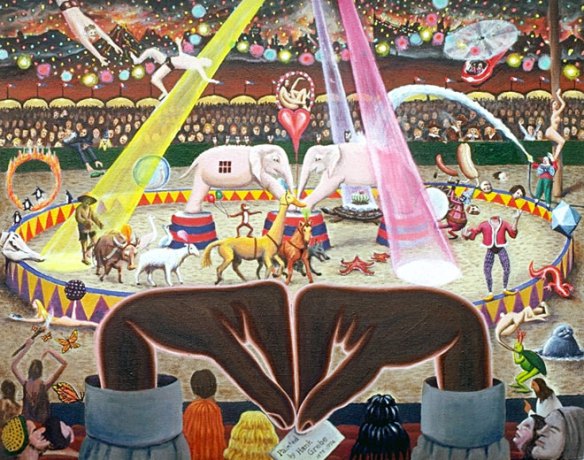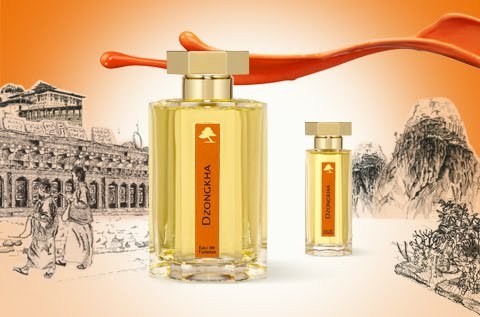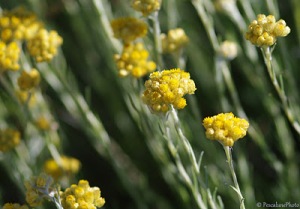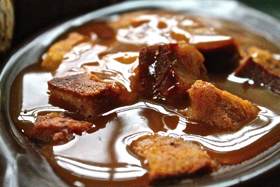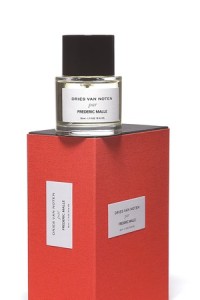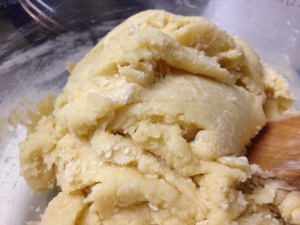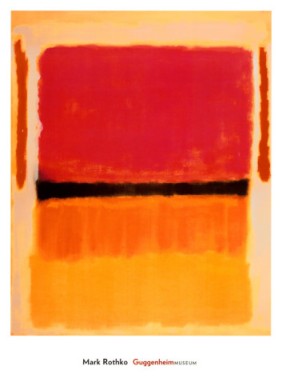
Untitled (Violet, Black, Orange, Yellow on White and Red), 1949. Source: The Guggenheim Museum.
There is something strangely captivating about Vanille from the highly admired perfume house of Mona di Orio. Vanille is part of Les Nombres d`Or Collection, and it is not your standard vanilla at all. Actually, the best way to sum up the perfume Vanille might be through analogy to the work of the famous painter, Mark Rothko, with his “Untitled (Violet, Black, Orange, Yellow on White and Red) 1949.” Like that painting, the perfume starts out as blood-red orange — and I mean that quite literally. Then, it turns into orange with the merest hints of yellow, before slowly transforming into creamy custardy yellow, custardy yellow on a darker, smoky, woody base, and, finally, into the palest of cream.
I wasn’t a fan of the blood-orange phase, and found Vanille’s opening to be almost a little nauseating, but the middle to end phases captured my interest. Almost against my will, I might add. Those of you who have read me for any amount of time know that I like neither very sweet perfumes nor gourmand ones. But, again, this is not your standard vanilla perfume. You might even argue that it is an Oriental-Gourmand hybrid at times, and one which merely happens to be heavily based on raw, concentrated vanilla. In the end, and taken as a whole, Mona di Orio Vanille was not my personal cup of tea, but I would definitely recommend it to those who adore non-traditional vanilla fragrances.
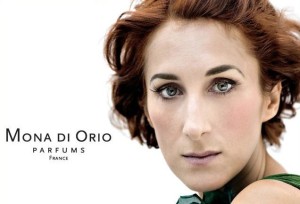 The company’s website explains the inspiration and character of the perfume, with a key point about how their key note differs from that used in some other vanilla perfumes:
The company’s website explains the inspiration and character of the perfume, with a key point about how their key note differs from that used in some other vanilla perfumes:
When composing Vanille, Mona di Orio imagined a romantic back story involving an old ship from long ago, on its way to Madagascar or the Comoros Islands, carrying precious cargo: rum barrels, oranges, vanilla beans, ylang-ylang, cloves and sandalwood …
Gourmand, smoky, and boozy with a subtle aromatic orange note lingering in the background, Vanille is one Bateau Ivre of perfectly blended notes that will derange your senses with its sensuality.Vanille opens with a shot of rum flavoured with orange rind and spiced with cloves. Amber and tonka further warm up this brew as ylang-ylang’s sharp sweetness joins with rich vanilla. Gaiac wood adds incensey smoke as woody notes from vetyver and sandalwood help to create an elegant finish.
But the real star of the show, not surprisingly, is vanilla. Instead of using ethyl vanillin, one of vanilla’s main components that can come across as powdery and sugary, di Orio used pure vanilla in this elixir. For a moment — amid this elegant orchestral arrangement of notes in the key of Vanilla — the pulpy, sensual creaminess of a split vanilla bean is right there in front of your nose. Delicious!
The exact notes are as follows:
Bitter Orange from Brazil, Rhum Absolute, Petitgrain, Clove, Vanilla from Madagascar, Tolu [Balsam, a resin], Gaiac Wood, Vetyver, Sandalwood, Ylang-Ylang, Tonka Bean, Leather, Musk, Amber.
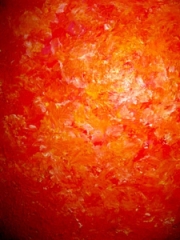
“The Orange Album – Abstract Art, Custom Painting, Imagery” by Bob Shelley at CustomMade.com
Vanille opens on my skin with a veritable explosion of orange in every form and variation possible. There is what feels like the most concentrated form of floral orange blossom, along with loads of highly sweetened blood orange, browned and very bitter petitgrain, and rummy Bourbon. This is orange to the Nth degree — sometimes blood-red in nature; heavily dark twig-brown; sometimes rum-like orange-brown, and always sweet. So, so sweet. Frankly, I’m a little overwhelmed.
Orange blossom is not listed in the notes but it is one of the most prominent notes to my nose during those opening minutes. Mona di Orio Vanille doesn’t feel like pulpy, orange or citrus fruits, but more like a combination of neroli and petitgrain. It has an oddly buttery feel to it — and I’m talking about actual melted butter. There are also touches of gaiac wood, the merest suggestion of cloves, and strong vetiver, all over a dry, smoky, vanilla base with cups of bitter petitgrain, and galloping gallons of Bourbon.
Bourbon is an American type of whiskey that is extremely sweet, and tinged with the wood from the charred-oak caskets in which it is aged. The alcohol note in Vanille has been compared to rum but, to me, it’s more akin to the woody, smoked aspect of sweet Bourbon. And it is such a huge part of the opening that the only way to really describe it all is to coin a new word: Bourbon-ized. Every note in the perfume is coated with Bourbon, but the main thrust is bourbonized orange blossom.
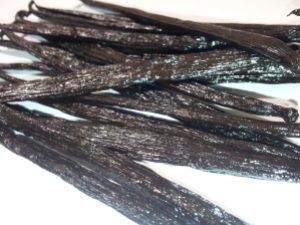 After about 5 minutes, the perfume starts to shift a little. Vanilla starts to rise to the surface. It is just like a freshly sliced vanilla pod; rich, raw, custardy, and potent. It immediately impacts the other notes, softening the orange blossom and taming the bitter petitgrain to something a little less sharp. It serves to alleviate some of the heavier aspects of the perfume that were, to me, unbearably cloying. And, with every passing moment, the sweetness drops — matched by a converse rise in the fragrance’s dry notes.
After about 5 minutes, the perfume starts to shift a little. Vanilla starts to rise to the surface. It is just like a freshly sliced vanilla pod; rich, raw, custardy, and potent. It immediately impacts the other notes, softening the orange blossom and taming the bitter petitgrain to something a little less sharp. It serves to alleviate some of the heavier aspects of the perfume that were, to me, unbearably cloying. And, with every passing moment, the sweetness drops — matched by a converse rise in the fragrance’s dry notes.
Less than fifteen minutes into the perfume’s development, Mona di Orio Vanille begins to turn into something much more nuanced and balanced. The pepper, smoke and woody notes appear (much to my relief) in a more individually distinct form. The gaiac wood is backed by the merest suggestion of cloves and earthy vetiver, but it is the slow, quiet, almost muted suggestion of smokiness in the background that I prefer. The perfume is still incredibly potent, rich and heavy, but it is not a cupcake sugariness or something that is purely gourmand. However, it is still far, far too rich for those who like airy, gauzy, sheer perfumes.
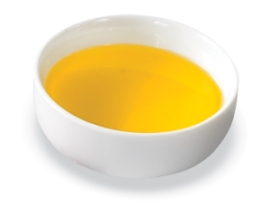
Clarified butter. Source: Sodahead.com
The note which perplexes me is something that definitely evokes the aroma of melted, clarified butter. I cannot explain it, but it is inescapable. I’ll tell you a brief story of my experience the other day. I planned to test the perfume, opened the vial to give it a sniff, but, then, suddenly, realised the time and that I had to go to my book club meeting. Unbeknownst to me, I must have gotten faint traces of Vanille on my fingers. Well, for the next two hours, I kept asking my hostess, “What is that smell of melted butter and vanilla?” She looked at me blankly, especially as I kept sniffing the air, my shirt, and parts of her kitchen like some sort of crazy person. I thought it may have been one of her hot, very buttered rolls that she had out, but it didn’t smell anything like the aroma that was haunting me. Finally, I realised that the scent came from two of my fingers. It was Mona di Orio’s Vanille. And, I’m telling you, it was just like the most concentrated form of highly sweetened, pure vanilla extract in a saucepan of bright yellow, sweet cream, Bourbon butter, with a touch of orange petitgrain. The note was there during both of my two, full tests of the perfume — and I really didn’t like it. Something about it called to mind the large canisters of cloying, heavy, butter oil that American movie cinemas use on popcorn.
Forty minutes into the development of the perfume, Mona di Orio Vanille is a strong vanilla custard with buttered Bourbon, followed by orange blossom, and muted hints of smoke and wood. On me, both the clove note and the dry, wood, smoke combination are significantly less than what others on Fragrantica and elsewhere have reported. Then, things start to get interesting. There is the merest whiff of ylang-ylang which just grows stronger as the time passes.
Less than 90 minutes in, the perfume becomes a wonderfully balanced, mellow, smooth, floral vanilla custard. The vanilla is still the dominant note, but it is tinged with airy ylang-ylang. The creaminess of the vanilla is perfectly complemented by the custardy, banana-like aspects of the flower which is, itself, balanced by its sheerness and lightness. Underneath it all, there are whispers of orange blossom, woods and vetiver. The buttery note is much more muted now (thank God), and the perfume feels significantly less opaque, gooey and unctuously sweet. In fact, even the sillage has dropped to a perfect amount, projecting in such a small cloud around you.
I started to smile and sniff my arm with some enthusiasm exactly two and a half hours in, when the sandalwood appeared. Creamy, soft, luxurious, rich sandalwood was intertwined sinuously with the vanilla, creating a silky, smooth, wonderfully blended scent. There were some mysteriously tantalizing hints of smoke and woodiness in the background that made Vanille seem a little more like an Oriental/Gourmand hybrid than a purely gourmand one. It’s almost as if there is some incense note but, like the clove one before it, it’s far from prominent on my skin. I still wouldn’t go so far as to call Vanille an incense-vanilla fragrance the way so many others do, but it is a lovely, subtle touch at this stage.
For reasons I can’t quite explain, Mona di Orio Vanille makes me think of Serge Lutens‘ Un Bois Vanillé which I like quite a bit. It’s a peculiar thought as they actually aren’t very alike. Mona di Orio’s perfume is monumentally richer, stronger, deeper, thicker, and more Oriental with its floral and smoky touches. The Lutens is milkier, creamier, with almond, licorice, light coconut, and honey. No flowers or buttered Bourbon at all. And the vanilla never feels raw, like concentrated pod paste as it does here with the Mona di Orio. However, Un Bois Vanillé does share the guaiac wood and sandalwood notes which combine with the vanilla to create a definitely smoky, woody, vanilla feel at certain stages — even if it is substantially lighter and milder. Perhaps the similarity in my mind stems from the fact that I haven’t encountered a lot of woody vanilla-sandalwood fragrances, as opposed to purely dessert and cupcake ones (which I despise).
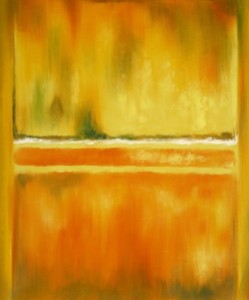
Mark Rothko. “No. 14-10 Yellow Greens.”
As the perfume starts the dry-down phase, a little over six hours later, Mona di Orio Vanille turns into a tonka vanilla perfume with sandalwood, quiet amber, a touch of wood, and subtle orange notes lurking in the background. It’s sheer, soft, and pleasant. In its final moments, about 9.5 hours, it’s really just simple tonka with some amorphous, lightly musked, woody note. All in all, Vanille lasted just short of 10 hours on my perfume-consuming skin. It was a strong perfume throughout much of its early development, but the sillage went from heavy to moderate by the second hour, then dropped further as the perfume progressed. It became a skin scent around the fifth hour.
The comments on Fragrantica are all over the place for Mona di Orio Vanille. The majority absolutely love it, calling it a well-balanced, smoky vanilla with lots of wood. A number find the opening to be unpleasant; a large number call the fragrance a dirty, complex vanilla that is their favorite; some compare the vanilla note to that in Dior‘s Addict; and a handful comment on how it is essentially “Rum, rum, rum. I hope you like rum, because…rum.” There are scattered statements here or there on how parts of the perfume are stomach-churning or “nearly nauseating.” I would bet you anything that it’s the Bourbonized butter and orange combination that the commentators are finding to be excessively cloying. I certainly felt queasy myself.
Yet, one of the bloggers whom I respect — The Non-Blonde — really adored this fragrance and you may find parts of her review to be instructive:
Vanille is reasonably sweet and somewhat ambery, but the main thing that’s amplified on my skin and tales me on some serious ride is sandalwood. Sandalwood like I haven’t smelled in ages: deep exotic and spicy as well as creamy. It’s a very posh cousin of the chai-sandalwood blend from Kenzo Jungle L’Elephant.
Vanille progresses from slightly boozy and intoxicating to smooth and mysterious. There’s no question about sex-appeal: this would get you sniffed and followed around. The vanilla is woven into every stage of the development and belongs there, be it as part of hot toddy, a treasured spice in a craved wooden box or a rare incense that sends you off on a fantasy journey.
If I had experienced as much sandalwood and incense on my skin as she seems to have done, I may have been a little more bowled over by the fragrance. I am certain, however, that I would still have enormous difficulty with the opening two hours. I’ve got some more of the Vanille (yet again) on my arm as we speak, and I simply cannot handle the Bourbon butter.
How you feel about Mona di Orio Vanille will really depend on how you feel about the main note, and gourmand fragrances as a whole. Those who love truly sweet, fully dessert-like fragrances may find it not to be sweet enough. This is no simple, uncomplicated Bath & Body Works vanilla. Those who enjoy the note in conjunction with other things may really appreciate this non-traditional, smoky woods and orange version of things. And those who are like me — who love spiced Orientals or super-charged florals, who wouldn’t go out of their way to experience a vanilla scent, and who eschew sweetness in any significant degree — may enjoy parts of the Mona di Orio, but not the whole. I definitely can’t see them being wow’ed enough by the overall experience to want a full bottle of it, especially as it costs $230. There are, however, different sizes and pricing options that may make Mona di Orio Vanille more accessible for those who adore their vanilla.
As a side note, this fragrance is absolutely nothing like Guerlain‘s Spiritueuse Double Vanille. Two very different kettles of fish. It’s been a long time since I smelled Annick Goutal Vanille Exquise, but, going on my memory of it, I don’t think the Goutal is similar, either. Despite deploying an incense twist on vanilla, it’s not as rich as the Mona di Orio, has much less concentrated vanilla, and includes quite a bit of bitter angelica. I believe Montale has a woody, boozy vanilla fragrance amongst its vast line, but I haven’t tried it. Lastly, Mona di Orio Vanille has absolutely nothing in common with Tom Ford‘s Private Blend Tobacco Vanille. The latter has dried tobacco leaves that occasionally create an impression of Christmas plum pudding. No part of Mona di Orio’s notes replicate the predominantly tobacco-woods or the spices in the Tom Ford. Furthermore, the type of vanilla and the fundamental nature of the fragrances are very different, too.
All in all, if you adore rich, sophisticated, boozy, vanilla fragrances with a non-traditional twist, you may want to give Mona di Orio’s Vanille a sniff.
DETAILS:
Cost, Sizes, Sets & Availability: Les Nombres d`Or Vanille is an eau de parfum, and comes in a variety of different options and sizes. The full bottle is 3.4 oz/100 ml and costs $230. It is available world-wide on the Mona di Orio website. In the U.S., you can find it at Luckyscent, Parfum1, and MinNewYork (which also offers free shipping within the US). There is also a Discovery Set of 8 x 5ml roll-on bottles of the entire Nombres d’Or collection which Mona di Orio sells for €90, and Luckyscent/ Parfum1 for $145. MinNY discounts the set for $5 off, pricing it at $140. Mona di Orio also offers a Travel Set of just the Vanille perfume in 3 bottles of 10 ml each, with the whole set priced at €85 (or about $110 with today’s currency conversion rate). That set is not offered at Luckyscent or Parfum1. In Canada, The Perfume Shoppe carries its own sort of “Discovery Set” of 4 perfumes in the Nombres d’Or collection, one of which is Vanille. It retails for CAD$100. Oddly, I don’t see the full bottle on their website when searching by brand name, but I found it via a Google search listed here and marked as “available.” It’s also marked as selling for $170, which I don’t understand at all. So, you may want to drop them an email. In the UK, you can find Vanille at Les Senteurs which sells it for £135.00 and which also carries a sample vial for sale. The perfume is also carried on Roullier White in the UK. In Paris, I see Mona di Orio listed on the Marie Antoinette Paris website but can’t find prices or individual perfumes for the line. For the rest of Europe, you can turn to Germany’s First in Fragrance which carries the perfume for €160.00, along with a Travel Kit of 3 x 10 ml bottles for €85, and a smaller sample for purchase. For all other countries from Russia to Netherlands to the UAE/Dubai, you can use the Store Locator guide on the company website. Samples: I obtained mine from Surrender to Chance which sells them starting at $6.99 for a 1 ml vial. Of course, you can also find samples at Luckyscent, Parfum1, and many of the European retailers linked to above.
 Dzing! is an eau de toilette fragrance from L’Artisan Parfumeur which seeks to evoke the circus. The woody scent was launched in 1999 and created by the highly respected perfumer, Olivia Giacobetti. The company describes it as follows:
Dzing! is an eau de toilette fragrance from L’Artisan Parfumeur which seeks to evoke the circus. The woody scent was launched in 1999 and created by the highly respected perfumer, Olivia Giacobetti. The company describes it as follows:
